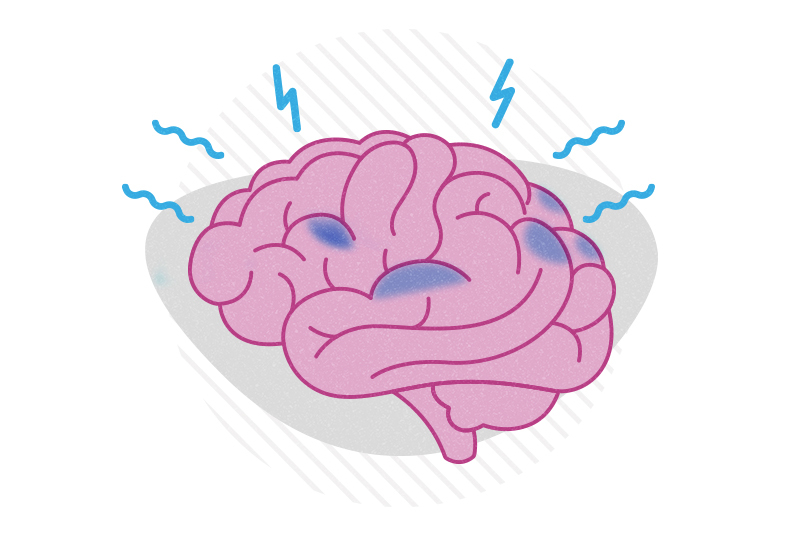Can we prevent seizures in Sturge-Weber syndrome?

Port wine stains — capillary malformations on the skin — are the most visible manifestation of Sturge-Weber syndrome. However, up to 60 percent of babies with birthmarks in high-risk locations (forehead and upper eyelid) also have capillary malformations in their brain. Of these, 75 to 90 percent will experience a seizure before the age of 2, posing a risk of brain injury and impaired neurodevelopment.
“The first question parents have is, ’Is my baby going to develop seizures?’” says neurologist Anna Pinto, MD, PhD, director of the Sturge-Weber clinic at Boston Children’s Hospital.
Is there a way to predict seizures and, more importantly, prevent them from occurring?
Pinto co-led a retrospective study, published earlier this year, that tried to answer these questions. She and her colleagues reviewed the charts of 92 infants with Sturge-Weber syndrome at Boston Children’s and the Kennedy Krieger Institute.
Thirty-two infants were pretreated with anti-epilepsy medications (including aspirin, levetiracetam, oxcarbazepine, and valproic acid) before any neurologic symptoms emerged. The remaining 60 infants were not pretreated.
Infants who were pretreated were less likely to develop seizures by the age of two years than infants who weren’t pretreated (53 vs. 88 percent). They also had better outcomes at age 2 when scored for seizure frequency, hemiparesis (one-sided weakness), visual field, and cognitive function.
Predicting seizure risk
But who are the right infants to treat? To answer that question, Pinto and Yangming Ou, PhD, in the Fetal-Neonatal Neuroimaging and Developmental Science Center and the Computational Health Informatics Program at Boston Children’s are studying infants from a half-dozen Sturge-Weber treatment centers around the country.
“We want to use a data-driven approach,” says Ou.
Using image analysis and machine learning techniques, Ou is comparing tens of thousands of MRIs from healthy brains with MRIs from infants with Sturge-Weber. He is also comparing MRIs from pretreated versus non-pretreated infants with Sturge-Weber.
The MRIs can detect capillary malformations on the brain, a risk factor for seizures, and any signs that the brain is suffering from a lack of blood perfusion. Ou, Pinto, and other collaborators will combine the MRI data with characteristics of the port wine stains to identify reliable predictors of seizure risk.
“Not every baby with a port wine stain will have brain involvement, says Pinto. “But when the port wine stain is bilateral or on the forehead or upper eyelid, we advise families to have brain MRIs. The location and extent of the birthmark could help us triage infants for intervention with a protection strategy.”
Paving the way to a clinical trial
Pinto and Ou also want to explore whether MRI and birthmark characteristics can predict outcomes in children who do develop seizures. Separately, they will look at outcomes of epilepsy surgery in children with Sturge-Weber.
The final step will be to treat infants at high risk for seizures in a prospective clinical trial.
“We used to tell parents, ‘Call me if your baby develops seizures,’” says Pinto. “Now we can predict whether seizures are likely to occur and decide whether to intervene. We can potentially change the natural history of a bad disease and change care for babies nationally and internationally.”
Refer a patient to the Sturge-Weber Syndrome Clinic
Related Posts :
-

Helping Jasmine manage Sturge-Weber syndrome before symptoms start
Sturge-Weber syndrome is a rare neurovascular disorder that increases the risk of seizures in infants due to abnormal blood vessel ...
-

Targeting treatments for vascular anomalies, courtesy of cancer genetics
Vascular anomalies — overgrowths or malformations of the capillaries, veins, arteries, and/or lymphatic vessels — often confound physicians, especially in acute ...
-

Gold particles and light could melt venous malformations away
Venous malformations — tissues made up largely of abnormally shaped veins — are often difficult to treat, especially when located in sensitive ...
-

What you should know about hemangiomas, according to a pediatric dermatologist
When parents discover that their infant has a hemangioma, a lot of questions usually follow. To find answers for the ...





